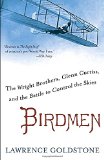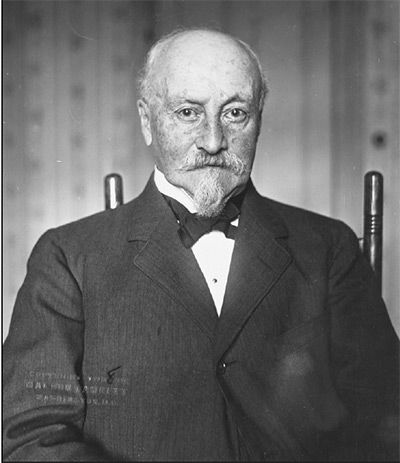Summary | Excerpt | Reviews | Beyond the Book | Readalikes | Genres & Themes | Author Bio
The Wright Brothers, Glenn Curtiss, and the Battle to Control the Skies

Critics' Opinion:
Readers' Opinion:
First Published:
May 2014, 448 pages
Paperback:
Apr 2015, 448 pages
 Book Reviewed by:
Book Reviewed by:
Poornima Apte
Buy This Book
For the next two decades, Chanute continued to push forward transportation engineering. He also perfected a means of pressure-treating wood with creosote that remained state-of- the- art for more than a century. When he retired in 1889, he did so as the foremost civil engineer in the United States and a very wealthy man. For all his personal achievements, however, Chanute never wavered in his commitment to a cooperative approach to problem solving. He attained leadership positions in a number of professional organizations and became active in civic groups in the cities in which he lived. As a result, which might be considered surprising for one so successful, Chanute had no real enemies and was well liked by virtually everyone who came in contact with him.
By 1890, he relocated to Chicago, but he wouldn't pass his remaining days sitting back with his feet up, and gazing out over Lake Michigan. His retirement had been prompted not by a desire to stop working but rather by the intention to pursue a passion that had been percolating for fifteen years. Chanute intended to bring the same skills and approach that had served him so well in his own career to the quest to achieve human flight.
It was not his intent initially to design aircraft but rather to serve as a catalyst, a focal point for the growing streams of theory and data then being generated about "the flying problem." The engineering methodology, he was convinced, the rigorous, thoughtful, step-by- step approach that created a bridge from the idea of a bridge, could be equally applied to heavier-than- air flight. Ideas therefore must be evaluated by peers and, if they showed promise, tested and incorporated in a body of knowledge available to all. Innovation should be rewarded, certainly, and inventions patented, but the process would be best served openly and collegially. Achieving flight for the advancement of humanity must always retain predominance over achieving the goal merely for profit.
Chanute proceeded to correspond with everyone who he could discern was working seriously on heavier-than- air flight and thus thrust himself into the forefront of the ongoing research without doing any of it on his own. One of his first and most important correspondents was an impoverished expatriate Frenchman living in Egypt named Louis Pierre Mouillard. Mouillard had trained in Paris as a painter but abandoned both the vocation and the city for a peripatetic existence in North Africa observing birds and attempting to replicate their flight. He built gliders and experimented with them in the sand dunes outside of Cairo. Although the test flights achieved very limited success, Mouillard developed some sophisticated and far-reaching insights concerning stability. He and Chanute would exchange letters until Mouillard's death in 1897 and more than once Chanute sent him money, as much for living expenses as to fund research. Chanute supplied journal articles and perspective gained from other correspondents; Mouillard supplied Chanute with his evaluations of glider mechanics, one of which may or may not have been so significant as to change the course of aeronautical research.

Octave Chanute.
On January 5, 1896, Mouillard wrote from his home in Cairo, "I have not been satisfied, among other things, with the controlling action of my moving planes (annularies) at the tips of the wings. I must greatly increase their importance. This device is indispensable. It was their absence which prevented Lilienthal from going farther; it is this which permits going to left and right." The "moving planes" to which he referred were hinged sections at the rear of each wing, primitive ailerons, which could be manipulated by the aviator to help control flight. Mouillard added, "Steering to the right or left is effected by the bird in many ways, such as a slight bending of the body in the direction desired, a part-folding of the wing on that side, a deformation of one wing-tip, so as to impede the air at that point and to turn upon it as a pivot, etc., etc." Mouillard's theorizing was sketchy and lacked specifics but whether his notion could be described as "altering lateral margins of the wings" was to cause enormous controversy in the years ahead.
Excerpted from Birdmen by Lawrence Goldstone. Copyright © 2014 by Lawrence Goldstone. Excerpted by permission of Ballantine Books. All rights reserved. No part of this excerpt may be reproduced or reprinted without permission in writing from the publisher.





The House on Biscayne Bay
by Chanel Cleeton
As death stalks a gothic mansion in Miami, the lives of two women intertwine as the past and present collide.

The Flower Sisters
by Michelle Collins Anderson
From the new Fannie Flagg of the Ozarks, a richly-woven story of family, forgiveness, and reinvention.

The Funeral Cryer by Wenyan Lu
Debut novelist Wenyan Lu brings us this witty yet profound story about one woman's midlife reawakening in contemporary rural China.
Your guide toexceptional books
BookBrowse seeks out and recommends the best in contemporary fiction and nonfiction—books that not only engage and entertain but also deepen our understanding of ourselves and the world around us.